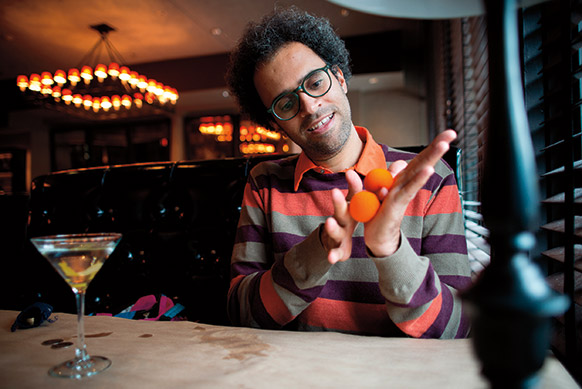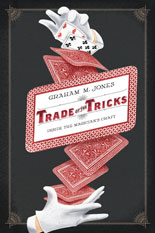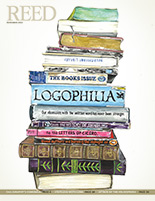
IRIS login | Reed College home Volume 91, No. 4: December 2012
The Books Issue
The Disappearing Trick

Photo by Kelly Creedon
Anthropologist Graham Jones ’97 reveals how magicians guard their craft in the internet age.
By Bill Donahue

Graham Jones ’97
Trade of the Tricks: Inside the Magician's Craft
University of California Press, 2011
When a magician pulls a rabbit out of his hat, most people just want to know how he did it. Was there a hole under the table? Was the guy somehow hiding a small, squirming herbivore inside his waistcoat?
Graham Jones asks deeper questions—the sort of questions you might expect from an anthropology professor at MIT. How, he wonders, did the magician learn the trick? With whom does he share his secret knowledge? How does he create an abracadabra stage persona that we can actually believe in, even though we live in a cynical age where anything magical is instantly presumed to be phony?
To research his first book, Trade of the Tricks, Jones spent a year inhabiting the bustling magician subculture of Paris. He hung out on street corners, watching the maestros at work. He frequented a smoky, cavernous bar as magicians grumbled about pay rates and boorish spectators. He learned how to pull a rabbit out of a hat, how to saw a lady in half, and how to conjure a pastry out of thin air.
But you will not find any how-to diagrams in his book. Trade of the Tricks does not come with a DVD walking amateurs through the basics. It is not, he writes, a book of secrets, but rather “a book about secrets . . . . The dynamism of magic depends on robust social networks and the sharing of intellectual resources. The magic scene, as I encountered it in Paris, takes shape through perpetually unfolding exchanges of knowledge and skill.”
Jones is intent on asking a question that has wide application in today’s knowledge economy: How do we strategically manipulate knowledge?
In one scene, he tells how a street performer, a magical éminence grise known as Bébel, explains what makes magic sing. It’s about style, not tricks, he says. “Magic requires mystery,” Bébel tells him. “You have to be magical. Every gesture and every utterance has to emanate magic.”
To demonstrate, Bébel shows how he inveigles a spectator’s playing card to the top of the deck. “He rotated his palms upward and wiggled his fingers in a rhythmical, rising motion,” Jones writes.
A craftsman like Bébel would despise Jones if he published shop secrets. Indeed, when magicians enter the preeminent French trade group, Fédération Française des Artistes Prestidigitateurs, they take an oath “neither to divulge any secrets that are part of illusionists’ cultural patrimony, nor to describe them in written or audiovisual materials intended for laymen.”
This oath is needed, for in the information age a magician’s secrets are a precious commodity. A few years ago, for example, the French television network FR3 produced the program Breaking the Magician’s Code: Magic’s Biggest Secrets Finally Revealed. The nation’s illusionists protested, en masse. In vain, they wrote to media outlets and politicians, urging that Breaking be squelched, to protect the public’s “right to dream.”
But of course magicians have to share secrets. The progress of their art depends on dialogue. Visiting a performer named Coco, Jones learns how nuanced the sharing can be. Coco reveals a new trick to a colleague and then insists, “Keep this to yourself. It mustn’t be disseminated too quickly because that lets us have something that other magicians don’t have.” A month later, he calls Coco to ask if he can share the trick with a friend. “No problem,” Coco tells him. “Share, share, share. But just as long as it comes out slowly so that not too many of us will know how to do it at first.”
Later, as he takes a private magic lesson, Jones learns more about secret sharing: His instructor, Stefan, shows him a new trick, but only after he gives Stefan one first. “You just traded me a beautiful one,” Stefan reasons, demonstrating that trick sharing among magicians is not about money, but is rooted in trust and veneration of craft. One of the interesting questions raised by Trade of the Tricks is whether this dynamic also applies to performers like classical violinists or skateboarders.
Unfortunately, Jones never shines as a magician. He admits, “I’m a C- or D-list performer at best.” After he left Paris in 2005 to write his dissertation, he ceased practicing magic. He retained the deepest respect for the art, though, and his book invokes Jean Cocteau’s description of magic as “more real than the reality we dream.” Likewise, he nods to the German philosopher Hegel, a magic connoisseur who, as Jones describes it, distinguished between “conjuring tricks” and “true works of art, which put expressive techniques in the service of transcendent truths.”
Trade of the Tricks is cerebral, but nimble in its erudite musings. Jones says he felt his thesis adviser, Bill Ray [French 1972–], looking over his shoulder as he wrote. Ray, he says, “taught me to take pride and pleasure in the scholar’s craft. He showed me that one can always strive for greater clarity in writing and greater depth in analysis. He is one of the most meticulous scholars I have ever met.”
At Reed, Jones was a lit major concentrating on French writers. Postgraduation, he enrolled at NYU and came across his thesis topic by chance. It was 2001. The Twin Towers had just fallen. He was writing a small paper on magic, and he realized that “In the face of a nightmarish world, magic is beautiful.”
He focused his sights on Paris because at the time France was marking the bicentennial birthday of Jean Eugène Robert-Houdin, the French aristocrat who brought what was once a lowbrow carnie pastime into the silky salon. “The French magic world was taking stock of itself,” he says. “It was asking, ‘Have we progressed?’”
The answer he heard most often was no. French illusionists tend to think that magic has cheapened of late, now that the internet has made its secrets readily available. Still, he came away seeing one subdiscipline—“close-up magic,” performed for small groups—as a salve to modern alienation. “It’s like slow food,” he says. “The magicians are independent artisans. They don’t have anyone writing their scripts. No one tells them how to dress. They’re vulnerable and human, and the spectators can look right into their eyes and touch their hands. They’re able to see magic made just for them.”
Since finishing his book, he has published an article in Cultural Anthropology on America’s “gospel magicians”—that is, evangelical Christians who entice prospective converts by dazzling them with stage tricks. He has also written an article about how adolescents gossip online. Still, old habits die hard. Delivering a lecture at MIT last year, he picked up a book which then burst into flames.
Wait, did he have a match up his sleeve? A small blowtorch, perhaps?
Don’t go there. Don’t even ask.


LATEST COMMENTS
steve-jobs-1976 I knew Steve Jobs when he was on the second floor of Quincy. (Fall...
Utnapishtim - 2 weeks ago
Prof. Mason Drukman [political science 1964–70] This is gold, pure gold. God bless, Prof. Drukman.
puredog - 1 month ago
virginia-davis-1965 Such a good friend & compatriot in the day of Satyricon...
czarchasm - 4 months ago
John Peara Baba 1990 John died of a broken heart from losing his mom and then his...
kodachrome - 7 months ago
Carol Sawyer 1962 Who wrote this obit? I'm writing something about Carol Sawyer...
MsLaurie Pepper - 8 months ago
William W. Wissman MAT 1969 ...and THREE sisters. Sabra, the oldest, Mary, the middle, and...
riclf - 10 months ago